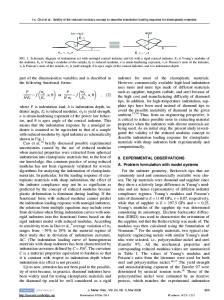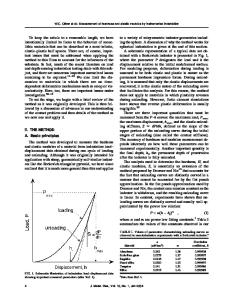The reduced modulus in the analysis of sharp instrumented indentation tests
- PDF / 304,337 Bytes
- 13 Pages / 584.957 x 782.986 pts Page_size
- 99 Downloads / 329 Views
orge Alcalá GRICCA-EUETIB, Universitat Politècnica de Catalunya, Barcelona 08036, Spain
Roberto M. Souza Department of Mechanical Engineering, Surface Phenomena Laboratory, University of São Paulo, 2231 05508-900 São Paulo, Brazil (Received 29 February 2012; accepted 30 April 2012)
In the analysis of instrumented indentation data, it is common practice to incorporate the combined moduli of the indenter (Ei) and the specimen (E) in the so-called reduced modulus (Er) to account for indenter deformation. Although indenter systems with rigid or elastic tips are considered as equivalent if Er is the same, the validity of this practice has been questioned over the years. The present work uses systematic finite element simulations to examine the role of the elastic deformation of the indenter tip in instrumented indentation measurements and the validity of the concept of the reduced modulus in conical and pyramidal (Berkovich) indentations. It is found that the apical angle increases as a result of the indenter deformation, which influences in the analysis of the results. Based upon the inaccuracies introduced by the reduced modulus approximation in the analysis of the unloading segment of instrumented indentation applied load (P)–penetration depth (d) curves, a detailed examination is then conducted on the role of indenter deformation upon the dimensionless functions describing the loading stages of such curves. Consequences of the present results in the extraction of the uniaxial stress–strain characteristics of the indented material through such dimensional analyses are finally illustrated. It is found that large overestimations in the assessment of the strain hardening behavior result by neglecting tip compliance. Guidelines are given in the paper to reduce such overestimations.
I. INTRODUCTION
Address all correspondence to this author. e-mail: [email protected] DOI: 10.1557/jmr.2012.164
Instrumented indentation tests are carried out with systems in which the indentation load and the indenter tip displacement are continuously registered. At any load stage, the total displacement, as measured by the transducer, is the sum of the true indenter displacement below the original specimen surface and the displacement of the load train of the system (i.e., the system compliance). Upon correction of measured load–displacement curve for machine compliance,1 the resulting curve shall ideally measure the correlation between the applied indentation load (P) and the distance of indenter–sample mutual approach (d). It is well known from classic linear elastic contact mechanics4 that d is not the magnitude of the indenter penetration below the original surface of the elastic half-space (hs) but the total displacement by which two remote points, one in the indenter and the other one in the half-space, approach each other. (Clarification is here needed in that while in our prior investigations, we use variable hs to denote measured penetration depth from the free surface,3,5 this is only so when dealing with rigid indenter tips.)
2148
Data Loading...










